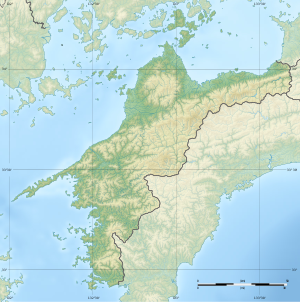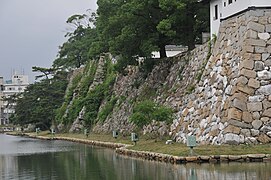Imabari Castle
| Imabari Castle | ||
|---|---|---|
|
Imabari Castle |
||
| Creation time : | 1602-1604 | |
| Castle type : | Umijiro (water castle) | |
| Conservation status: | Partly reconstructed | |
| Place: | Imabari | |
| Geographical location | 34 ° 3 '48 " N , 133 ° 0' 24.5" E | |
|
|
||
The Castle Imabari ( Japanese 今治城 , Imabari-jō ) is located in the city of Imabari , Ehime Prefecture . A smaller branch of the Hisamatsu-Matsudaira with an income of 30,000 koku last resided there in the Edo period .
Along with Takamatsu Castle and Nakatsu Castle, it is one of the "Three Great Water Castles of Japan" ( 日本 三 大海 城 , Nihon sandai umijiro ).
Lords of the castle in the Edo period
- From 1602: the Tōdō Takatora with an income of 220,000 koku .
- From 1635: a branch of the Matsudaira (Hisamatsu) with 30,000 koku.
history
Imabari Castle is at sea level on the edge of the Seto Inland Sea . Tōdō Takatora, who received a quarter of the province of Iyo after the Battle of Sekigahara , began construction in 1602, followed by the construction of the samurai quarter the following year . In 1604 the work was finished, but in 1608 Takatora received the province of Iga and two districts of the province of Ise . The castle tower was dismantled and used in 1610 for the castle in Kameyama in the Tamba province . It was a gift to Tokugawa Ieyasu and is said to have existed there until the Meiji Restoration in 1868. After Takatora had moved to Ise, he kept in the province of Iyo two counties as exclave ( 飛地 , tobichi ) and sat there his adopted son Takayoshi one, was preserved so that the Castle Imabari.
In 1635 the Tōdō in Imabari were replaced by a branch of the Hisamatsu-Matsudaira, who then resided there until the Meiji Restoration with an income of 30,000 Koku.
The castle consisted of the central portion, that of a moat surrounding Hommaru, surrounded on the land side in the north on three sides by the second district, the Ni-no-Maru, also by a moat, was protected. In the north the third district, San-no-maru, which was surrounded by a third moat, joined. This moat was connected to the inland sea by a branch channel, making the castle one of the few water castles in Japan.
The Hommaru and its wide moat have been preserved. The castle tower and a watchtower were rebuilt. Part of the wall crowning with elongated, low structures for defense, a tamon ( 多 聞 ), can be seen. On the premises are the large Fukiake Shrine ( 吹 揚 神社 , Fukiage-jinja ) and the smaller Sarutahiko Shrine ( 猿 田 彦 神社 , Sarutahiko-jinja ).
State of reconstruction
The reconstruction only affects the inner courtyard and the associated moat. The castle tower, called Tenshu, is a concrete structure from 1980, which only corresponds to the original structure from the outside. Inside there are various exhibitions on each floor of the five-story tower, with regard to weapons and armor, documents and photos of various Japanese castles. The natural history museum of the city of Imabari is also housed in the tower. The floors themselves do not correspond to the original condition or their distribution. The top floor serves as a lookout point. The first main gate to the castle has not been reconstructed, only the Kurogane-gomon that followed was rebuilt, as was the Bugu-yagura tower. Both are reconstructed with the inner workings in which the history of the castle is explained with a model and various Japanese films . Two corner towers, Yamazato-yagura and Okane-yagura, have also been reconstructed and house an antiques museum in which everyday objects such as B. irons and rice cookers from different eras up to modern times are shown, or a museum for local art.
photos
Web links
literature
- Ikeda, Kōichi: Imabari-jo in: Miura, Masayuki (Ed.): Shiro to jinya. Saikoku-hen. Gakken, 2006. ISBN 978-4-05-604379-2 .








